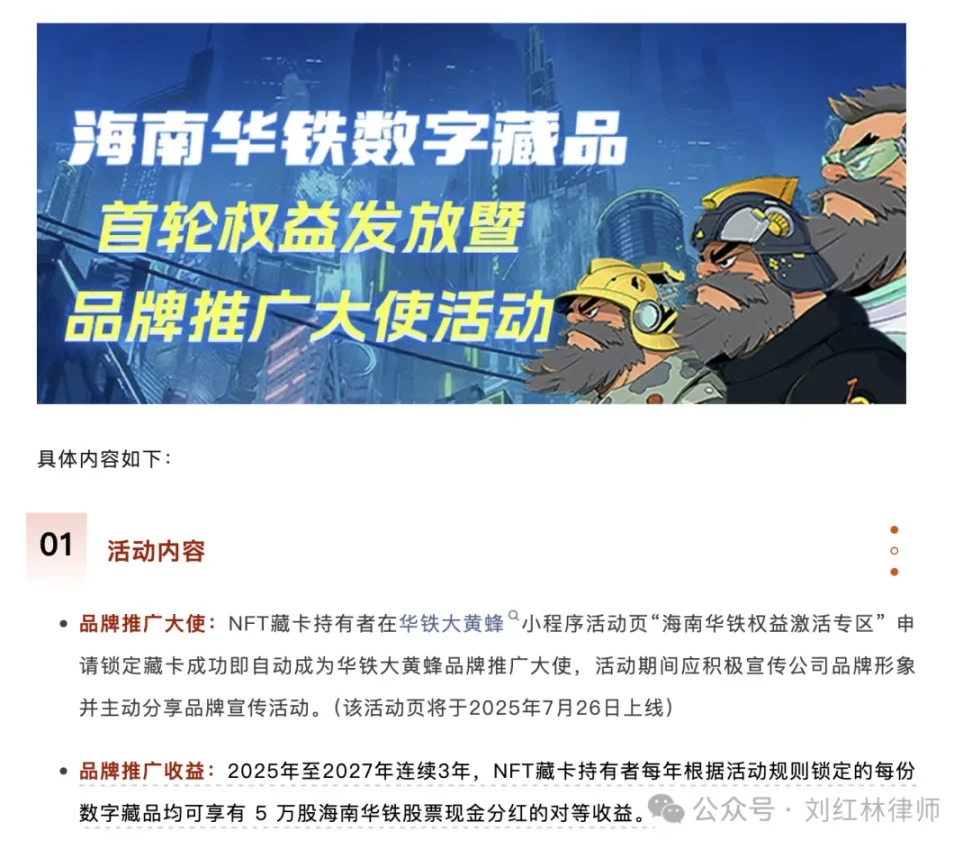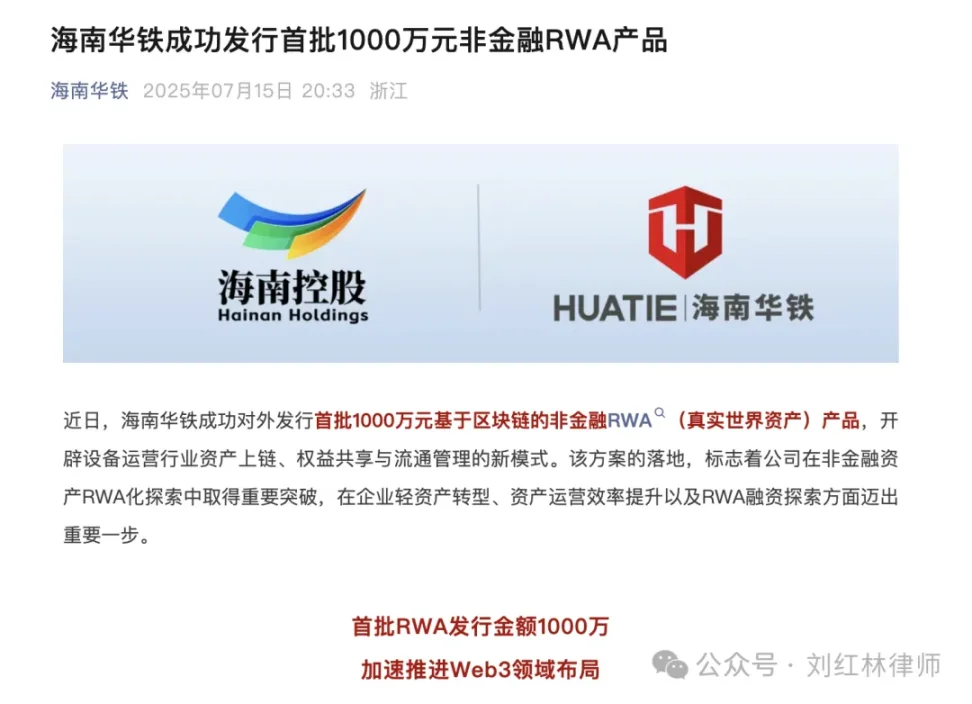Author: Liu Honglin
In the past few days, Hainan Huatie suddenly became a common topic in the Web3 circle and the A-share community.
On one hand, the 'Wasp Brother NFT' floor price rose from 200 yuan to nearly 15,000 yuan within three days, making waves in the digital collectible circle; on the other hand, the company announced the completion of the first batch of 10 million yuan non-financial RWA (real-world asset) product issuance, with a partner being the well-known licensed Web3 company Wei Yi Digital. To many bewildered onlookers, this seems to be a new signal of 'public companies entering Web3', a model of 'on-chain assets + revenue dividends'.
Outsiders watch for excitement, while insiders look for the essence. Hainan Huatie's seemingly innovative play, from NFT to RWA, actually 'walks' in the legal and regulatory gray area.
Lawyer Honglin's personal view is: Hainan Huatie is not a compliance pilot worth encouraging, but may instead become a typical case of future risk outbreaks.
From NFT to RWA: What is Hainan Huatie really playing at?
First, let's talk about NFT, which is 'Wasp Brother'.
This NFT is not just a simple digital collectible, but is tied to the rights of 'brand promotion revenue' for three consecutive years. According to the official rules released by the company in July, as long as users activate and lock the NFT through the 'Hua Tie Da Huang Feng' WeChat mini-program between July 26 and August 1, they automatically become 'brand promotion ambassadors' and can receive cash benefits equivalent to 'the dividend amount of 50,000 shares of Hainan Huatie stock' for three consecutive years from 2025 to 2027.

The key point of this model is:
The revenue amount is linked to the company's stock dividends;
Locking the card is a prerequisite for eligibility, and it must be reactivated every year;
The company reserves the unilateral right to interpret and revoke eligibility;
Once a user makes remarks online that 'damage the brand image', eligibility may be revoked.
In short, you are not buying a collectible, but signing an unequal agreement of 'behavior code in exchange for revenue rights'.
Then we look at the RWA project. This is Hainan Huatie's attempt to take a further step in the industry narrative of 'asset on-chain'.

The company claims to have collaborated with licensed Web3 company Wei Yi Digital to complete the issuance of the first batch of non-financial RWA products amounting to 10 million yuan.
Unlike common RWA related to real estate or accounts receivable, this product does not involve the transfer of ownership of equipment but digitally maps the 'usage rights + operating rights' of its equipment, forming a structure similar to a 'digital membership card', allowing users to circulate through on-chain transfers, consignment sales, etc., while enjoying certain usage rights or benefits.
The key points of this RWA play are:
Digitization of usage rights, rather than asset splitting or securitization;
Does not constitute a transfer of ownership, thus not falling under the securities regulatory framework;
Assets are registered on-chain, but the realization of rights still relies on offline processes;
Market-oriented attempts using a 'device leasing + Web3 rights card' hybrid model.
To put it bluntly, these 'digital cards' are more like 'virtual leasing rights certificates' for engineering equipment, just packaged into a new concept of 'RWA', completing rights registration on-chain and introducing transferability. Combined with the brand dissemination mechanism of NFTs, Hainan Huatie has constructed a composite structure of 'heavy asset operating company + on-chain digital rights + user promotion dividends'.
At first glance, this structure feels very Web3, as it digitalizes assets, incentivizes users, and drives short-term topic dissemination. But the problem is— all these 'innovations' tread on the edge of regulatory red lines, even intentionally blurring legal boundaries.
This is not innovation, but serious borderline behavior.
I do not deny that Hainan Huatie has innovative ideas in digital asset operations, but precisely because it is not a native Web3 company, it is more likely to fall into the problem of 'using old thinking to wrap new shells'.
In my opinion, this model has at least the following three major issues.
The rights structure is unclear, and revenue payouts depend on the company's will, leaving users unable to protect their rights.
Whether it is the 'dividend equivalent income' obtained from locking the NFT or the 'equipment usage rights' corresponding to RWA, the final realization is not based on real legal contracts or smart contracts but entirely relies on a company's rule, a small program, and a payment account registration. This model is essentially the company 'talking to itself': when it is willing to distribute, you can get it; when it does not want to, you cannot get it and have no right to pursue it.
Such a rights structure neither constitutes an executable civil contract nor applies to securities or consumer protection mechanisms. Once revenue defaults, qualifications are revoked, or rules change, users have no place to appeal.
'Speech censorship + revenue incentives' combined is an infringement on community governance.
Hainan Huatie’s rules clearly state: anyone who spreads adverse remarks on social networks may have their rights revoked by the company. This design of writing 'speech control' into NFT revenue rules appears to be 'brand protection', but in essence, it is a systematic suppression of users' freedom of expression.
Web3 is about freedom and autonomy, not 'you can only earn money if you like it'. If this practice is imitated by other companies, the future of digital collectibles will no longer be a space for spontaneous expression of user culture and community, but a 'brand mouthpiece' bound by revenue. This is not ecosystem building, but a public relations tool disguised as NFT.
RWA structure blurs the boundaries of financial products, or harbors the suspicion of 'illegal disguised fundraising'.
This time, Hainan Huatie did not split asset ownership but bundled usage rights into NFTs or digital cards, combined with dividend revenues. The reason this practice has not been defined by regulators is that it avoids one or two of the three major characteristics of 'public fundraising + promised returns + no financial license'. But the structure itself is still very close to 'quasi-financial products'.
Once the project continues to expand, increases the scale of RWA, designs various rights combinations, or introduces third-party platform transactions and expected revenue lock-ups, it can easily be classified as 'disguised sale of financial products', or even touch the boundary of illegally absorbing public deposits. Especially in the current tightening of financial regulation, such 'cross-border innovation' can easily be held accountable if it triggers public opinion or user rights protection.
Lawyer Mankun reminds
The biggest problem with this round of Hainan Huatie's operations is not how bold the marketing is, but that the legal structure and compliance design it relies on are too fragile.
For ordinary users:
The NFT you bought is not a property right, nor a stock certificate; it is only an 'activity qualification that the company says you can earn money from';
Once the rules change, the company suffers losses, or there are public opinion storms, your 'equivalent dividends' may become worthless;
All rights have no legal guarantee and lack judicial enforceability; the risk relies entirely on 'trusting the company'.
For Web3 entrepreneurs:
Do not take Hainan Huatie's actions as an industry model; it solved the issues of dissemination and popularity but did not address legal ownership and user trust mechanisms;
If RWA is to be done, it can start from the structure of non-financial assets, but it cannot skip the three lines of compliance, contracts, and governance;
NFTs can carry brands and interactions, but cannot replace contracts, shares, and rights, otherwise, it will eventually lead to trouble.
Conclusion: Do not mistake probing boundaries for breakthroughs.
Hainan Huatie has indeed become popular and is indeed 'new'. But new does not equal correct, and popular does not equal stable.
As a compliance lawyer in the Web3 industry, I hope to see more innovative attempts from listed companies, but the premise of this hope is legality, transparency, sustainability, rather than wrapping old systems, old logic, and unequal user relationships in 'Web3 packaging'.
Do not treat probing regulatory red lines as a breakthrough in the system. That is not progress, but playing with fire.



